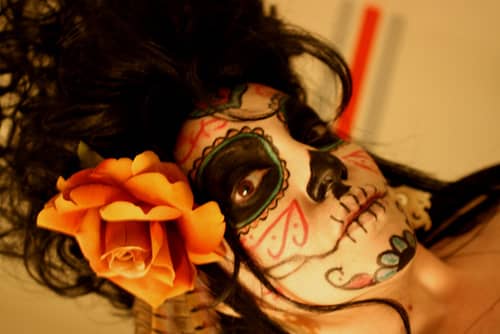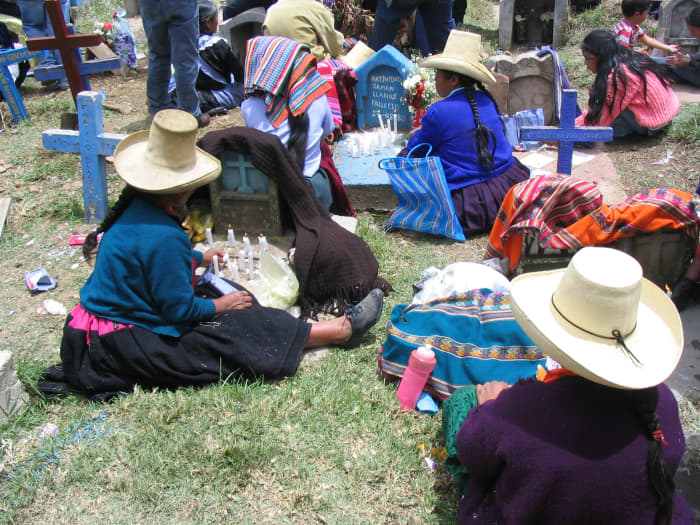What Art Is Used During the Day of the Dead
Marie has been an online freelance writer for over eight years. She has a item involvement in culture and history.
What Practice 24-hour interval of the Dead Face Painting Designs Hateful?
A mixture of Aztec and European symbolism infuse the meaning of Dia de los Muertos (Twenty-four hour period of the Expressionless) face painting designs. The tradition is a mixture of Cosmic beliefs with the religions of indigenous Mexican people.
The most common design is to paint the face up to resemble a skull. For people not familiar with Latin American civilization, this might seem foreign and fifty-fifty scary. Yet, the skull has a uniquely positive meaning in Dias de los Muertos, very different from the skeletons and ghosts of Halloween. The multi-day holiday is an opportunity for families and friends to get together, pray for, honor, celebrate, and think friends and family members who have died.
One of the more common symbols of the holiday is the skull (or calavera), a design which celebrants brandish in food (sugar or chocolate shaped like skulls), masks called calacas (skeletons), and (most recently) face paint.
Symbols in Day of the Dead Face-Painting
Skulls
Although the face painting is not exactly an aboriginal tradition, the calavera pattern itself is quite one-time. Skulls—known as calaveras or calacas in United mexican states—are an essential function of the symbolism of Dia de los Muertos in Mexico. They are used not just as the basis for painting faces, but besides are the shape of candy such as saccharide skulls and for many skeleton-inspired decorations.
The mean solar day of the dead in United mexican states is a fascinating mixture of Spanish Catholic and native Aztec traditions and beliefs. Skulls and skeletons were an important part of All Saints Day festivals in medieval Europe, especially since the Black Death ravaged the population of Europe in the 1300s. Across Europe, artists, playwrights, and poets take mused on the theme of 'memento mori' (reminders that nosotros all must die one day) and the 'dance of the expressionless.' Many artworks and books depicted dancing skeletons or portraits with skull faces.
At the same fourth dimension, in Mexico, the Aztec culture believed life on earth to be something of an illusion—expiry was a positive footstep forwards into a higher level of consciousness. For the Aztecs, skulls were a positive symbol, not only of death but also of rebirth.
People in United mexican states wear traditional skull masks, and the tradition of painting faces to await similar skulls has grown up as a variation of this practice. Masks have always been powerful objects in many cultures, ones that often let the wearer to go far touch with their darker, chaotic side. Skull face painting is a run a risk to overcome the fright of death, human activity recklessly, and get up to the mischief that is forbidden at other times of the year!

Dia de los muertos face up-painting often mixes skulls with flowers.
Flowers
Flowers are also symbolically of import. Many skull designs incorporate flowers, and the i that is almost closely associated with Dia de los Muertos is the marigold, or cempazúchitl, which is known equally the flower of the expressionless. In Aztec conventionalities, the marigold was sacred to Mictlantecuhtli, the god of the dead. When the souls of departed family and friends return to globe, it is believed the strong scent of marigold helps to guide them back.
Flowers are oftentimes incorporated into the confront-painted skull designs (and tattoos, for that matter). This mixing of skulls and flowers may seem foreign to some, unless you recall their purpose, to overcome the fear of death and celebrate life!

Indigenous people in Peru commemorate 24-hour interval of the Dead by visiting the graves of loved ones.

Catrina figures from Mexico.
Elegant Skulls: La Catrina
Skulls may seem neither elegant nor feminine at first glance, but the elegant skull has grown into an important day of the expressionless tradition.
La Calavera Catrina (the Elegant Skull) is a 1913 etching by José Guadalupe Posada. The prototype shows a skeleton dressed in the finery of a wealthy lady, a reminder that fifty-fifty the rich and cute carry death inside them. Nowadays, la calavera catrina is a source of inspiration for women'southward skull face-painting, which is both scary and beautiful at once.
Scroll to Proceed
Read More From Holidappy
In Mexico, it is mutual to see 'catrinas' around the time of the Dia de los Muertos. They are figurines of ladies in fancy dresses, but with bare skulls showing under their flowery hats.

Posada's 1913 etching of La Calavera Catrina
© 2011 Marie McKeown
olivia on October 25, 2018:
How do u detect source cited stuff on this?
bruce on October 17, 2018:
im am so thankful
Amanda Edwards on August eighteen, 2018:
Give thanks you for explaining this.
Aidan Yard. on March 08, 2018:
I am looking to see if any of the item shapes they utilise hateful anything. I understand the list of colours and what they represent, and of form, it does mention the marigolds, but the different dots, and swirls and other designs around information technology, are those just designs or does each shape represent something?
Justin Bieber on Feb 20, 2018:
Cool
Thrjtjtjt on January 17, 2018:
Wow this is interesting
Thomas on December 04, 2017:
Why do they panti there face
how-do-you-do on November 01, 2017:
what do colours correspond on the painted skull
Yo on Oct xxx, 2017:
why are they sometimes one-half painted?
Boi from the dead on September 27, 2017:
I establish this interesting
JustMe... on September 13, 2017:
Good read. Thx
Isabel M on October 27, 2015:
This website is awesome
ashley chiliad on November 01, 2013:
Sorry I ment lost love...
ashley m on Nov 01, 2013:
I call up the pregnant behind the half face painting is listing love like pregnant half of you died because your non with the one you dear
Elizabeth on Nov 01, 2013:
I am curious to know also...Is there a meaning backside half the face being painted?
Djs434 on October 21, 2013:
Is there a special meaning for those who only paint a half face?
Marie McKeown (author) from Republic of ireland on August 26, 2013:
Estoy de acuerdo!
HolidayGiftIdea on August 23, 2013:
Me gusta el dia de los muertos! Pienso que es interesante como todos somos difereentes. Asi anidimos valor porque no todos somos la misma persona.
methhead on October 31, 2012:
kool
Marie McKeown (author) from Ireland on October 24, 2012:
I am glad y'all did too - thank you for your feedback!
Marla Barton on October 24, 2012:
Wow,Im glad I read this!
Marie McKeown (author) from Ireland on Oct fifteen, 2012:
Practice y'all have something particular in heed?
Boo on October fifteen, 2012:
I need good meanings
ugh on October 08, 2012:
I know its cool right dam dam
Marie McKeown (author) from Ireland on Nov 01, 2011:
Cheers Tina. I'thousand not the author of the youtube clip but I searched through the options to find a good i - the girl does a good job of explaining it all, doesn't she?
Tina Clippinger on November 01, 2011:
2011 I accept watched almost EVERY dia de los muertos carbohydrate skull tutorial on YouTube. Yours is precious in that you used the most basic and affordable face painting kit. I used that very Klutz kit when my kids were lilliputian on 100s of little faces. You demonstrated the dazzler of the makeup presented in a elementary, doable form. Thank you.
D Kane on October 30, 2011:
I have been trying to notice the meaning of the face up pigment for my tattoo and this was such a helpful article. Give thanks you!
Tara Lani on October 05, 2011:
I love Dia de los Muertos everything! And what a neat tutorial. Cheers and so much. 2011
Source: https://holidappy.com/holidays/Meaning-Dia-de-los-Muertos-Face-Painting
0 Response to "What Art Is Used During the Day of the Dead"
Post a Comment